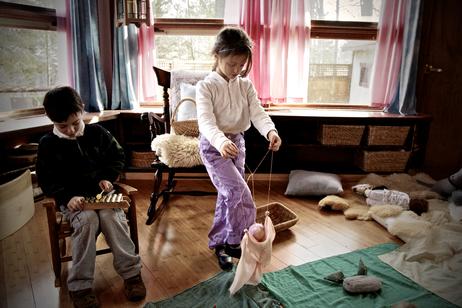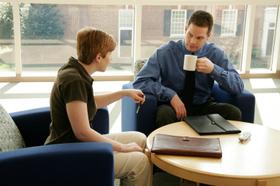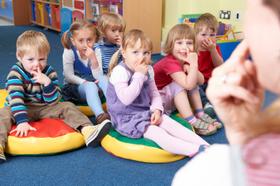I asked Vicki Larson to give us some detailed answers to my questions about Waldorf education. (I must disclaim that my eldest daughter attended a Waldorf school.) Vicki is the Director of Communications and Marketing at Green Meadow Waldorf School in Chestnut Ridge, New York. She is also the school's Alumni Relations Coordinator and Diversity Committee Chair. ~ Rob Kennedy
What sets a Waldorf school apart from public schools? Is it curriculum? Teaching style? Philosophy? Other characteristics?
The Waldorf curriculum differs from a public school or other independent school curriculum in philosophy, teaching style, and the kinds of relationships the students develop with their teachers and classmates.
Philosophy: Uniquely designed to meet children at each developmental stage, Waldorf Education is based on child study and observation. Our academically challenging, arts-infused curriculum includes block-style learning and develops adults who have the opportunity to reach their full potential, excelling in many areas unafraid to take risks as they work to solve problems. In our school environment, academic standards are rigorous, and stress is minimized by strong relationships, ample artistic and physical activity, and opportunities for joy and discovery. Media and technology are managed very differently than in many other schools: they are introduced in an age-appropriate way. They are understood and used as tools rather than ends unto themselves. Waldorf Schools do not "teach to the test" (as independent schools, we are often exempt from state testing, though most Waldorf students take the SAT and other standardized tests), and we prioritize experiential learning. We also believe that natural materials are best for children: wooden toys and silk cloths for play, plant-dyed wool for handwork classes, and quality art materials that nourish the child's physical body and educate the aesthetic sense.
Relationships: Waldorf Education exposes children to a broad curriculum, and our teachers are able to bring out the potential within each student, in accordance with the Latin root of the word “educare,” meaning “to draw out.” Waldorf education intrinsically nurtures the development of lifelong relationships and a sense of community, and also offers students invaluable opportunities to work through challenges, fostering essential social skills. Three key aspects of the education make this possible. Class Teachers often guide their students through several years, providing continuity and stability for the students as they develop and transform. Class Teachers are supported by a constellation of expert subject teachers who share in shepherding the class through the years. Classes of students grow together from first through twelfth grades. These three relationship threads braid together, forming a social and human foundation from which education grows.
Waldorf education is the fastest-growing independent school movement worldwide, with nearly 300 schools in the US and almost 1,000 worldwide. The curriculum is based on the philosophy of Rudolf Steiner, who founded the first Waldorf School in Germany in 1919. Green Meadow Waldorf School offers developmentally based, challenging academic coursework infused with the arts. Students are exposed to diverse disciplines and can choose traditional classes, such as modern languages and science,s while learning practical arts, such as knitting, blacksmithing, and woodworking. The school also limits the use of technology and media for younger students, which is now understood by researchers as essential to the developing brain.
Is a Waldorf teacher trained differently from other teachers?
Yes. Many Waldorf teachers are also state-certified, and some have taught in other schools (like public or Montessori) before becoming Waldorf teachers. I think this sums it up better than I can:
From the AWSNA site:
The Art of Being a Waldorf Teacher
In the heart of a Waldorf teacher lives the commitment to help each student reach his or her highest potential. Waldorf teacher preparation gives you a deep understanding of the whole human being as it unfolds through the critical phases of toddler, child, and teenager—so you can guide students on their life journey.
Equally important is the Waldorf teacher’s commitment to ongoing self-development. Waldorf teacher preparation stretches you in all directions— socially, intellectually, physically, and artistically—to push you beyond your comfort zones and help you develop the capacities needed to inspire your students.
Waldorf teaching is, above all, an art. Waldorf teacher preparation builds the capacities needed to create lively, memorable lessons in which your students are engaged and self-motivated. Your colleagues in teacher preparation—as well as your fellow teachers in a Waldorf school—will help you continue to grow and develop.
How do parents know that a Waldorf school is the real thing?
Waldorf Schools are accredited by the Association of Waldorf Schools of North America (AWSNA), and also often accredited by a state or national body like the NY State Association of Independent Schools (NYSAIS) or the National Association of Independent Schools (NAIS). Additionally, Waldorf Early Childhood programs are accredited by the Waldorf Early Childhood Association of North America (WECAN), which requires that all teachers and assistants be Waldorf-certified. Schools using the term "Waldorf-inspired" are not accredited by AWSNA, and teachers in those schools are often not certified Waldorf teachers.
Describe a typical day in the primary school.
Each day at most Waldorf Schools begins with “main lesson,” a period of about two hours, in which a given academic subject is studied intensively for three to four weeks (called a block), allowing for in-depth study and integration of the material.
Students are presented with new concepts and skills in language arts, math, science, and social studies. Integrating art with all academic work develops new ways of thinking and working, as the students literally take the work into their own hands. Our students experience a deep investment in their learning as they create their main-lesson books with compositions, observations, illustrations, and diagrams of their studies. The Main Lesson includes Language Arts, Mathematics, The Sciences, Geography, Culture, and History.
After the Main Lesson comes a snack, ample outdoor play, lunch, and then specialty classes in the afternoon to round out the curriculum. Students will learn to knit, crochet, feel, and sew in handwork; will carve bowls and spoons in woodwork; learn Spanish and German; become proficient in movement, sports, and singing; and learn how to play an instrument in orchestra. All students participate in these classes during their time in the lower school at GMWS.
Subjects needing extra practice in areas such as math, writing, and foreign language are also taught in shorter afternoon periods.
Trips and class plays are essential components of the education throughout all 12 years: Starting in third grade, students go on an overnight trip during the year. After the third-grade farm trip, students in subsequent years go on camping trips, where they learn how to canoe, hike, raft, and use outdoor survival skills. This culminates with the eighth-grade trip, which often includes a service component. Classes in the upper grades often take field trips to Boston, Washington, or Philadelphia, focusing on the rich history of these cities. Recent day trips have included visiting Hindu and Buddhist temples, ice skating at Bear Mountain, singing Gregorian chants at the Cathedral of St. John the Divine, and touring the New York Botanical Garden.
Alongside this rich academic curriculum, the students draw and paint, sing and memorize poetry, and rehearse and perform plays with their Class Teacher. Each class performs a play every year, ranging from a fifteen-minute retelling of a fairy tale with the first graders to a near-full-length play in the eighth grade. Recent eighth grade plays/musicals at Green Meadow Waldorf School have included The Magic Flute, The Pirates of Penzance, Inherit the Wind, Twelfth Night, and Romeo and Juliet. By the time a student has reached eighth grade, he or she will have acted in many roles, and will have helped with set design, lighting, and costuming.
Describe a typical day in the high school.
The High School also follows a schedule of Main Lesson followed by specialty classes.
Each day at a Waldorf High School begins with “main lesson,” a one-hour-and-40-minute period in which an academic subject is studied intensively for three to four weeks. Studying a subject in blocks allows students the opportunity to gain a detailed understanding of the subject through a combination of college-style lecture, discussion, and hands on work. During the course of a main lesson block, students will keep a main lesson book, or portfolio, in which they will
record studies using notes, sketches, essays, and other writings, illustrations, and diagrams.
Extra-curricular Activities, Community Service, Class Trips, Athletics and Study Abroad, and Senior Projects and Internships round out the High School experience.
A note about Senior Projects: A widely anticipated event in the school year is the presentation of senior class projects. Alongside regular class and extra-curricular commitments, each senior selects a personal project for the year. The range of projects is always striking, from EMT training to filmmaking, from automobile reconditioning to wilderness survival, from business entrepreneurship to dance.
Results: Waldorf graduates are accepted at the nation’s most selective colleges, where they are prized for their genuine intellectual curiosity, their can-do attitude, and their ability to engage fully in their learning.
Over 94% of Waldorf graduates attend college, with 88% completing their degrees. This compares favorably with the 90% of private high-school graduates that attend college and the 76% of private school graduates that complete their college careers. Waldorf graduates are 3 times as likely to study social and behavioral sciences and 2 times more likely to study science and math than the general US population. Waldorf graduates go on to careers in such varied fields as law, politics, teaching, information technology, the arts, social services, business, and medicine.
Well-known graduates of Waldorf Schools include Matthaus Atkinson (Project Engineer, NASA), Kenneth Chenault (CEO and Chairman of American Express), Julianna Margulies, Ferdinand Alexander Porsche (automotive engineer and designer for Porsche), Charles Rose (internationally known, award-winning architect), Aram Roston (CNN correspondent and newspaper reporter), and Jens Stoltenberg (Prime Minister of Norway).
Over 90% of Green Meadow graduates pursue college degrees. They attend a variety of colleges, including some of the best-known and most prestigious schools in the country.
Questions? Contact us on Facebook and Instagram. @privateschoolreview






















